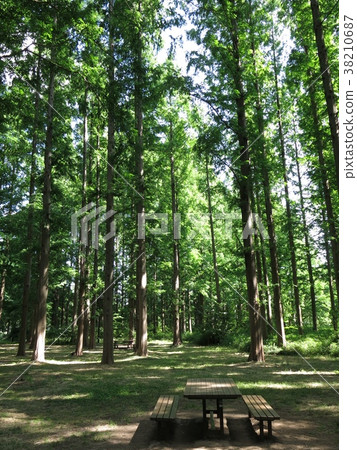Metasequoia Forest Camping


Somewhere in the Sauraton Mountains of North Carolina, lies the Crescent Ridge Dawn Redwoods Preserve; a private endeavor to re-establish a self regulating forest of metasequoia in the Appalachian region. Here, among 50 acres of misty hills and hollows, dawn redwoods flourish in an environment strikingly similar to the Sichuan and Hubei provinces of China. Located some five to six hundred miles further to the north, but at a lower altitude, CRDRP provides a virtually identical, although slightly cooler, climate to the Chinese forests in the Shui-sa Valley that Metasequoia has called home for the past several million years. In China, dawn redwoods grow amidst oak, sweetgum, sassafras, hemlock, chestnut, and Katsura trees. | |||||
| |||||
| |||||
The preserve is tentatively scheduled to open to the public in 2035. Visitors will be able to wander pathways through groves of dawn redwoods. The project's goal is 5000+ metasequoias, plus the other large species mentioned earlier. “I have laid the preserve out like the national parks out west,” Doug says, “Just on a smaller scale. We will simulate old growth characteristics, such as a planted ‘fairy ring’, to serve as a natural pulpit for wedding ceremonies. People will walk on pathways created before the trees were planted, giving the effect of ancient Indian trails. The trails will open into pure groves of dawn redwoods with mixed forest in between. We would also like to design one or two hilltop overlooks with views of the surrounding mountains, and possibly even a cabled suspension bridge across one of the hollows to bring visitors through the treetops of dawn redwoods.” | |||||
| CRDRP will also offer a Visitor's Center, with films and interpretive exhibits, including many fossils of Metasequoia, silicified cones, petrified wood, and samples of dawn redwood, including a section of log. It will also feature anything “metasequoia related”, such as stamps, articles, photographs, etc. A preview of this can be seen here on the site, in the “Cool Stuff” area. As the project progresses, more information will become available, and hopefully added to the site for reference. | |||||
The location of the preserve must remain vague, at least for now, for obvious reasons. If people knew there were redwoods in the vicinity, they might search for giant trees, possibly trampling seedlings in their quest. Vandalism would also be likely to occur. So for now, the exact location of the Crescent Ridge Dawn Redwoods Preserve must remain a secret, except to a few individuals in related fields. People who are genuinely interested in the project may contact Special Ranger Doug Hanks for further information. We at the Crescent Ridge Dawn Redwoods Preserve hope you have | |||||
Doug Hanks © 2005 | |||||

Metasequoia Forest California
Metasequoia glyptostroboides 'Ogon' is commonly known by the trade name Metasequoia glyptostroboides 'Gold Rush'. It is a fast-growing selection of dawn redwood with pleasing bright yellow feathery foliage that will turn tawny brown before being shed in the fall. Metasequoia is a riparian species, and before habitation the valley floor may well have been a Metasequoia forest. Metasequoia trees that occur away from the valley floor are restricted to the moist bottoms of ravines and draws that drain into the main valley. Metasequoia glyptostroboides, commonly called dawn redwood, is a deciduous, coniferous tree that grows in a conical shape to 100’ tall. It is related to and closely resembles bald cypress (Taxodium) and redwood (Sequoia). From fossil records, dawn redwood is known to. S omewhere in the Sauraton Mountains of North Carolina, lies the Crescent Ridge Dawn Redwoods Preserve; a private endeavor to re-establish a self regulating forest of metasequoia.

